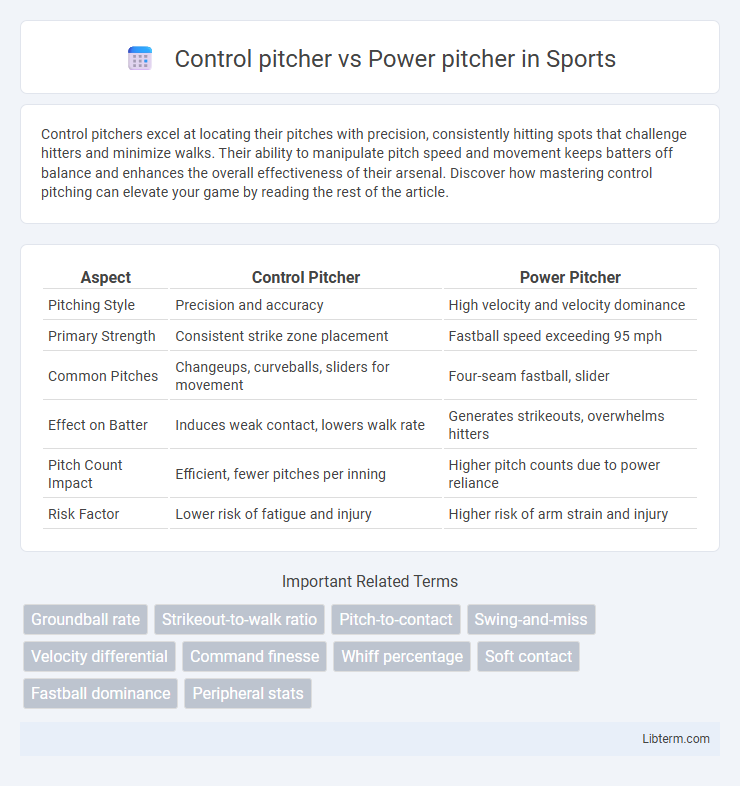Control pitchers excel at locating their pitches with precision, consistently hitting spots that challenge hitters and minimize walks. Their ability to manipulate pitch speed and movement keeps batters off balance and enhances the overall effectiveness of their arsenal. Discover how mastering control pitching can elevate your game by reading the rest of the article.
Table of Comparison
| Aspect | Control Pitcher | Power Pitcher |
|---|---|---|
| Pitching Style | Precision and accuracy | High velocity and velocity dominance |
| Primary Strength | Consistent strike zone placement | Fastball speed exceeding 95 mph |
| Common Pitches | Changeups, curveballs, sliders for movement | Four-seam fastball, slider |
| Effect on Batter | Induces weak contact, lowers walk rate | Generates strikeouts, overwhelms hitters |
| Pitch Count Impact | Efficient, fewer pitches per inning | Higher pitch counts due to power reliance |
| Risk Factor | Lower risk of fatigue and injury | Higher risk of arm strain and injury |
Understanding Pitching Styles: Control vs Power
Control pitchers prioritize accuracy and pitch placement, consistently hitting their spots to induce weak contact and minimize walks. Power pitchers rely on high velocity and overpowering pitches, often aiming to strike out batters with fastballs reaching 95+ mph. The effectiveness of each style depends on a pitcher's ability to maintain balance between control and velocity, adapting to hitters and game situations.
Defining the Control Pitcher
A Control pitcher excels in accuracy, consistently locating pitches within the strike zone to minimize walks and induce weak contact. Unlike Power pitchers who rely on speed and strikeouts, Control pitchers use precision and pitch selection to outsmart batters. Their effectiveness hinges on command over multiple pitch types, enabling strategic placement over sheer velocity.
Characteristics of a Power Pitcher
A power pitcher is characterized by a high-velocity fastball, often exceeding 95 mph, and a dominating presence on the mound, relying on sheer speed and strikeout ability to overpower hitters. They typically possess a limited pitch repertoire focused on maximizing velocity rather than precise control, leading to higher strikeout rates but also increased walk rates. Power pitchers excel in generating swings and misses with sharp sliders or curveballs complementing their fastball, making them valuable assets in high-leverage situations.
Key Differences Between Control and Power Pitchers
Control pitchers excel in pitch accuracy and command, consistently placing the ball in precise locations to induce weak contact or strikeouts. Power pitchers rely primarily on velocity, often throwing fastballs exceeding 95 mph to overpower hitters and generate swings and misses. The key difference lies in the strategic approach: control pitchers emphasize finesse and pitch placement, while power pitchers focus on raw speed and strikeout potential.
Advantages of Being a Control Pitcher
Control pitchers excel in accuracy and pitch placement, significantly reducing walks and maintaining a lower pitch count which prolongs their effectiveness in a game. Their ability to induce weak contact through precise location enhances ground ball and strikeout rates, minimizing the reliance on velocity. This strategic precision improves run prevention and generates higher efficiency, making control pitchers valuable assets in high-pressure situations and long-term pitching success.
Benefits and Risks of Power Pitching
Power pitching delivers high velocity fastballs that can overpower hitters, increasing strikeout rates and reducing contact opportunities. The benefits include dominating the strike zone and intimidating batters, but risks involve higher injury potential due to stress on the arm and decreased pitch control leading to more walks. Maintaining balanced mechanics and conditioning is crucial to maximize power pitching effectiveness while minimizing physical strain.
Pitch Selection: Accuracy vs Velocity
Control pitchers rely on precise pitch selection and pinpoint accuracy to consistently place the ball in the strike zone, often focusing on breaking balls and off-speed pitches to deceive hitters. Power pitchers prioritize velocity, using fastballs that can exceed 95 mph to overwhelm batters, often sacrificing pinpoint accuracy for speed and strikeout potential. The strategic balance between accuracy and velocity defines their pitching styles, with control pitchers excelling at avoiding walks and power pitchers thriving on strikeouts.
Impact on Game Strategy: Control vs Power
Control pitchers influence game strategy by emphasizing precision and minimizing walks, forcing batters into consistent contact and allowing defenses to capitalize on ground balls and double plays. Power pitchers shift strategy towards strikeouts and limiting ball-in-play opportunities, often relying on velocity and movement to overpower hitters and shorten innings. Teams adjust defense positioning and bullpen usage depending on whether a control or power pitcher is on the mound, optimizing for pitch count management and situational matchups.
Famous Examples: Control Pitchers and Power Pitchers
Famous control pitchers like Greg Maddux and Tom Glavine excel in pinpoint accuracy and strategic pitch placement, relying on finesse rather than velocity to dominate hitters. In contrast, power pitchers such as Nolan Ryan and Randy Johnson captivate with their overwhelming fastballs, frequently exceeding 95 mph, intimidating batters with sheer speed and strikeout capability. These pitching styles illustrate the distinct approaches to achieving success on the mound within Major League Baseball.
Which Pitching Style Dominates Modern Baseball?
Control pitchers, known for their precision and ability to consistently locate pitches, increasingly dominate modern baseball due to the premium placed on minimizing walks and inducing weak contact. Power pitchers rely on high velocity fastballs and strikeouts, but the trend favors control to enhance efficiency and prevent high pitch counts. Advanced analytics highlight that combining control with effective velocity yields the most success in today's pitching landscape.
Control pitcher Infographic

 libterm.com
libterm.com